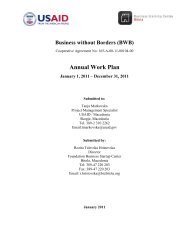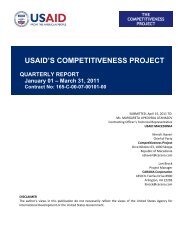FINAL REPORT - USAID Macedonia
FINAL REPORT - USAID Macedonia
FINAL REPORT - USAID Macedonia
You also want an ePaper? Increase the reach of your titles
YUMPU automatically turns print PDFs into web optimized ePapers that Google loves.
The Project’s management was structured to facilitate effective planning and implementation across vertical and<br />
horizontal components. While activities were managed by specific component teams, significant crossfertilization<br />
increased cost-effectiveness and overall impact. Many beneficiaries benefited from both vertical<br />
(e.g. participation in trade shows) and horizontal (e.g. finance, training, and certification) activities. MCP’s<br />
organizational structure, including key staff and implementing partners, is presented in Figure 3.<br />
Economic Crisis and Long-term View<br />
The <strong>Macedonia</strong> Competitiveness Project (MCP) took place during<br />
the global financial crisis and the tepid economic recovery. Between<br />
2008 and 2009, demand fell sharply in most markets, including<br />
sectors covered by MCP, like apparel and light manufacturing. For a<br />
time, flat sales and job retention was considered a success, as many<br />
<strong>Macedonia</strong>n companies faced work stoppages and lay-offs. At the<br />
same time, tight credit conditions made it difficult for companies to<br />
access the finance required for working capital or investments in<br />
upgrades. This market uncertainty, combined with global credit<br />
challenges caused many potential investors to put plans on hold. As<br />
the impact of the economic crisis waned and demand returned<br />
(albeit slowly) in 2010 and 2011, factories saw orders return and<br />
were able to start hiring orders again. That said, orders remained<br />
smaller than prior to the crisis, and prices remain depressed, making<br />
it hard for companies to be profitable and improve their financial<br />
position. In the last year of the project, the economic recovery<br />
continued, although the debt crisis in neighboring Greece and fear<br />
of a double-dip recession in Europe resulted in uncertainty and<br />
ongoing demand, pricing, and credit pressures.<br />
The economic crisis presented challenges that impacted MCP<br />
programming decisions, priorities, and results. During the first half<br />
of the project, when the effects of the economic crisis were<br />
particularly severe, it became clear that transactional outcomes (e.g.<br />
sales, exports, investment) would be negatively impacted over the<br />
near term. In this context, the MCP team took a long-term perspective on the way it approached project<br />
implementation and focused on activities likely to have transformational, or systemic, impacts that will outlast<br />
the recession—and help <strong>Macedonia</strong> and its companies surge as the economy recovers. Examples include:<br />
� Helping companies make the financial and human resources to become more productive, develop new<br />
products, and build the capacity to reposition themselves within value chains;<br />
� Addressing systemic workforce development issues;<br />
� Investing in long-term market relationships to result in fruitful orders when economic recovery takes hold;<br />
� Engaging investors and strategic partners to find lower-cost locations as part of their long-term strategy; and<br />
� Encouraging a logistics park investment as a platform for new investment and industries.<br />
This long-term view availed MCP the opportunity to focus on developing, piloting, and implementing high<br />
impact and scalable initiatives (e.g. financial platform and MyCareer) that produced accelerated results in<br />
investment, job creation and exports.<br />
Building platforms<br />
Within the context of its transformational perspective to enhancing competitiveness, MCP piloted and—when<br />
successful—rolled-out effective service packages to support <strong>Macedonia</strong>n companies and supply chains as they<br />
responded to opportunities and challenges in global markets. These platforms were designed to be sustainable<br />
9<br />
Transactional vs. Transformational<br />
MCP designed activities to be either<br />
transactional or transformational in nature<br />
and impact. Transactional activities focused<br />
on helping a company or supply chain<br />
realize a short‐to‐medium term objective,<br />
most often related to pursuing a specific<br />
market opportunity, whereas<br />
transformational activities were designed<br />
to have a longer‐term impact horizon.<br />
Transformational activities can take many<br />
forms, including using a market opportunity<br />
to drive change and upgrades within a<br />
company or sector, providing sustainable<br />
solutions to a critical market failure, or<br />
supporting investments and strategic<br />
partnerships that raise companies and<br />
supply chains to a new level of market<br />
engagement.<br />
While transformational activities often<br />
required longer implementation periods,<br />
their impact on future export growth and<br />
competitiveness is more significant.




